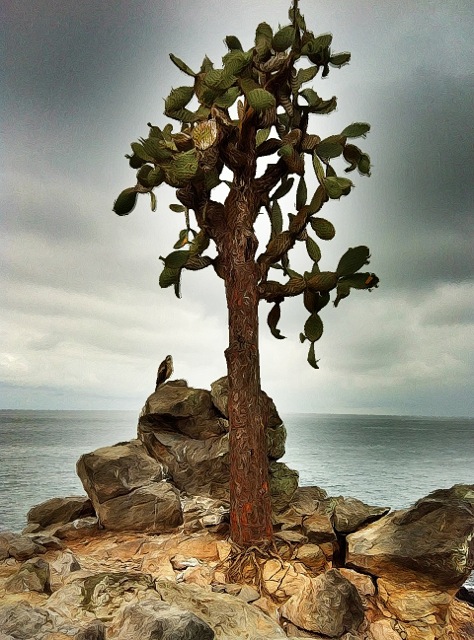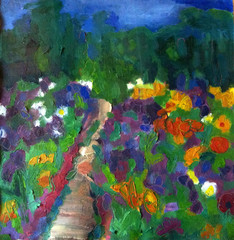A Feast For The Eyes Is Food For The Soul
The next time you have a potluck dinner, be sure to invite Elizabeth .jpg) Murray. Very likely she will bring a pot of homemade soup, a bouquet of splashy flowers, tales from the Amazon, and wisdom for the broken heart.
Murray. Very likely she will bring a pot of homemade soup, a bouquet of splashy flowers, tales from the Amazon, and wisdom for the broken heart.
This artist, gardener, writer, and speaker has lived a life as rich and varied as the flowers she cultivates. In childhood she has found that Spirit is pervasive in nature, and she has taken comfort and guidance from it ever since. She studied botany, art, and environmental studies in college. She moved to Maine to live off the land. She was inspired to travel to Japan and Bali and learned of their stylized gardens. Then in 1985 came the opportunity to help restore the famous gardens of Claude Monet in Giverny, France. It was there she came to understand how they not only inspired his art, but how their vibrational energy healed his depression. For 25 years she has returned to capture these landscapes in photographs made famous in her book, Monet’s Passion, and subsequent calendars and other publications. Just last year 375,000 visitors to the New York Botanical Gardens ooo’d and ahhh’d their way through a joint exhibit of her photographs and his paintings.
As she explai ns, it is this very “ahhh” experience that connects us to God because beauty is a reflection of the sacred. But we needn’t live in Giverny to experience this. “Create beauty in simple ways, in your homes and dress, not expensively, but with order and intentionality. Unfortunately beauty has become trivialized, as with the cosmetic industry. But we can take it back, open our hearts, and treat it like a message. We can find it in nature or create it ourselves.”
ns, it is this very “ahhh” experience that connects us to God because beauty is a reflection of the sacred. But we needn’t live in Giverny to experience this. “Create beauty in simple ways, in your homes and dress, not expensively, but with order and intentionality. Unfortunately beauty has become trivialized, as with the cosmetic industry. But we can take it back, open our hearts, and treat it like a message. We can find it in nature or create it ourselves.”
Elizabeth has found it not only at home but also in extraordinary landscapes and peoples. She had the good fortune to visit with the Achuar people in the Amazon through the Pachamama Alliance. They are an ancient culture that makes decisions based on dreams. They plan their individual days by them and, in this story, their new cultural direction. Fifteen years ago the village dreamed that it was time to let heart-centered people in to help them protect the “lungs of the earth”—trees. She was invited to be one of them. She brought in art supplies and had the children draw pictures of one of their myths. Then she had it translated into three languages: Achuar, Spanish, and English. Nantu and Auju: How the Moon and Potoo Bird Came to Be is now a book available free to schools and libraries. The experience reaffirmed for her how deeply we all are interconnected and that the sacred expresses itself everywhere to us and through us.
This philosophy has been critical to Elizabeth’s personal survival and growth. Family crises and tragedies filled her childhood and adolescence. It was a palpable relationship with Spirit through nature that nourished her, keeping hope and faith alive. In addition a strong, loving mentor from her  Quaker community encouraged her to travel widely and be of service others. All this was essential to helping her face her biggest challenge, the death of her husband from cancer after a marriage of seven and a half and months. She recalls a poem by Rumi who said that love breaks our hearts open. There was a lot of bitterness and depression she had to work through, she said. But when the broken heart remains open, its capacity to give and receive love and compassion grows greater than we can possibly imagine. This sentiment is particularly apparent to her in her service to bereaved families. While she makes floral arrangements for many occasions, those for funerals are especially sacred to her. She reminds us that life can’t be perfect and authentic at the same time. So rather than saving, savor the moments of beauty, delight, and love as they happen.
Quaker community encouraged her to travel widely and be of service others. All this was essential to helping her face her biggest challenge, the death of her husband from cancer after a marriage of seven and a half and months. She recalls a poem by Rumi who said that love breaks our hearts open. There was a lot of bitterness and depression she had to work through, she said. But when the broken heart remains open, its capacity to give and receive love and compassion grows greater than we can possibly imagine. This sentiment is particularly apparent to her in her service to bereaved families. While she makes floral arrangements for many occasions, those for funerals are especially sacred to her. She reminds us that life can’t be perfect and authentic at the same time. So rather than saving, savor the moments of beauty, delight, and love as they happen.
Trials and tragedies leave us reeling to be sure. When asked how one copes with uncertainty or feeling stuck, Elizabeth offered several suggestions. Move your body; get out of your head and do yoga, dance, garden, take a walk. Say a prayer and ask for guidance. Let go of the need for perfection; something beyond what you could ever think of comes through when you do that. Pose a question to God, your angels, a loved one who has passed on by writing it out in your dominant hand; then allow a response to come through while writing with your non-dominant hand. She knows first hand how powerful this can be.
Such a spiritual inquiry has led to a new book that she is  just finishing up. Desiring a new way to communicate to others how to find their passion and what the world needs, she prayed for guidance, and Living Life in Full Bloom was born. This work, to be published in January 2014, outlines archetypes and 30 different practices for each to help you find your true north: The Artist, representing imagination and creativity; The Lover who shows us what we want to protect and commit to; Spirit Weaver for celebration, rituals, and the sacred space we create for Spirit; and The Gardener which symbolizes our intimacy with nature. It includes stories of those who embody these archetypes as well as other valuable resources. She will also be conducting a workshop based on the book over four weekends. Again, see her website (www.elizabethmurray.com) for details if you are interested.
just finishing up. Desiring a new way to communicate to others how to find their passion and what the world needs, she prayed for guidance, and Living Life in Full Bloom was born. This work, to be published in January 2014, outlines archetypes and 30 different practices for each to help you find your true north: The Artist, representing imagination and creativity; The Lover who shows us what we want to protect and commit to; Spirit Weaver for celebration, rituals, and the sacred space we create for Spirit; and The Gardener which symbolizes our intimacy with nature. It includes stories of those who embody these archetypes as well as other valuable resources. She will also be conducting a workshop based on the book over four weekends. Again, see her website (www.elizabethmurray.com) for details if you are interested.
A conversation with Elizabeth is as nourishing as it is exquisite. It leaves us inspired to see anew the beauty that is right before us and how we can create it ourselves. As she says, “I feel sacredness in beauty and even say a prayer before I photograph something that it will open people’s hearts. I believe there is a healing vibration in beauty.”
Amen. Would someone please pass the soup?
Posted by Janis Daddona on Mar 1, 2013



On Mar 1, 2013 Bela Shah wrote:
Post Your Reply